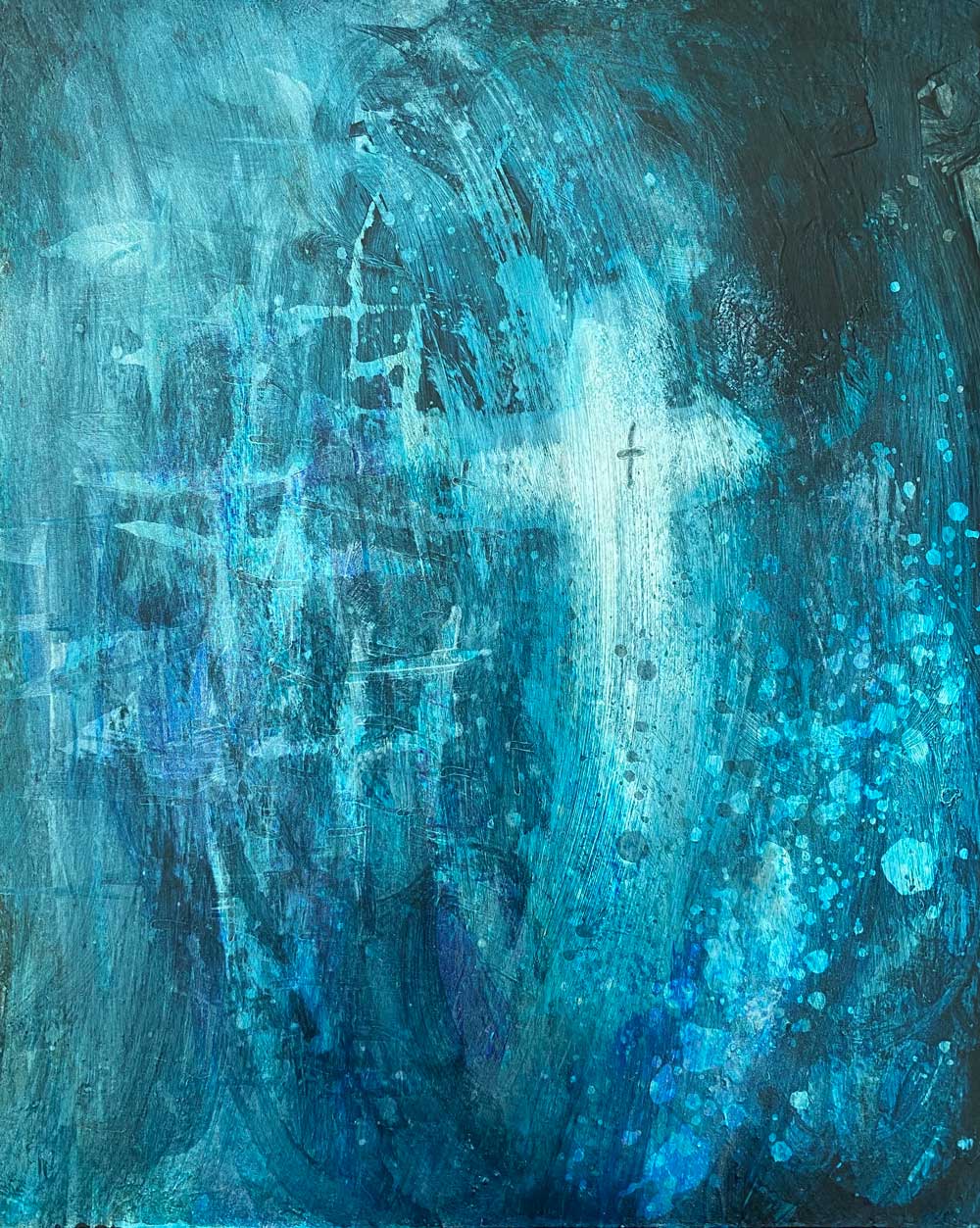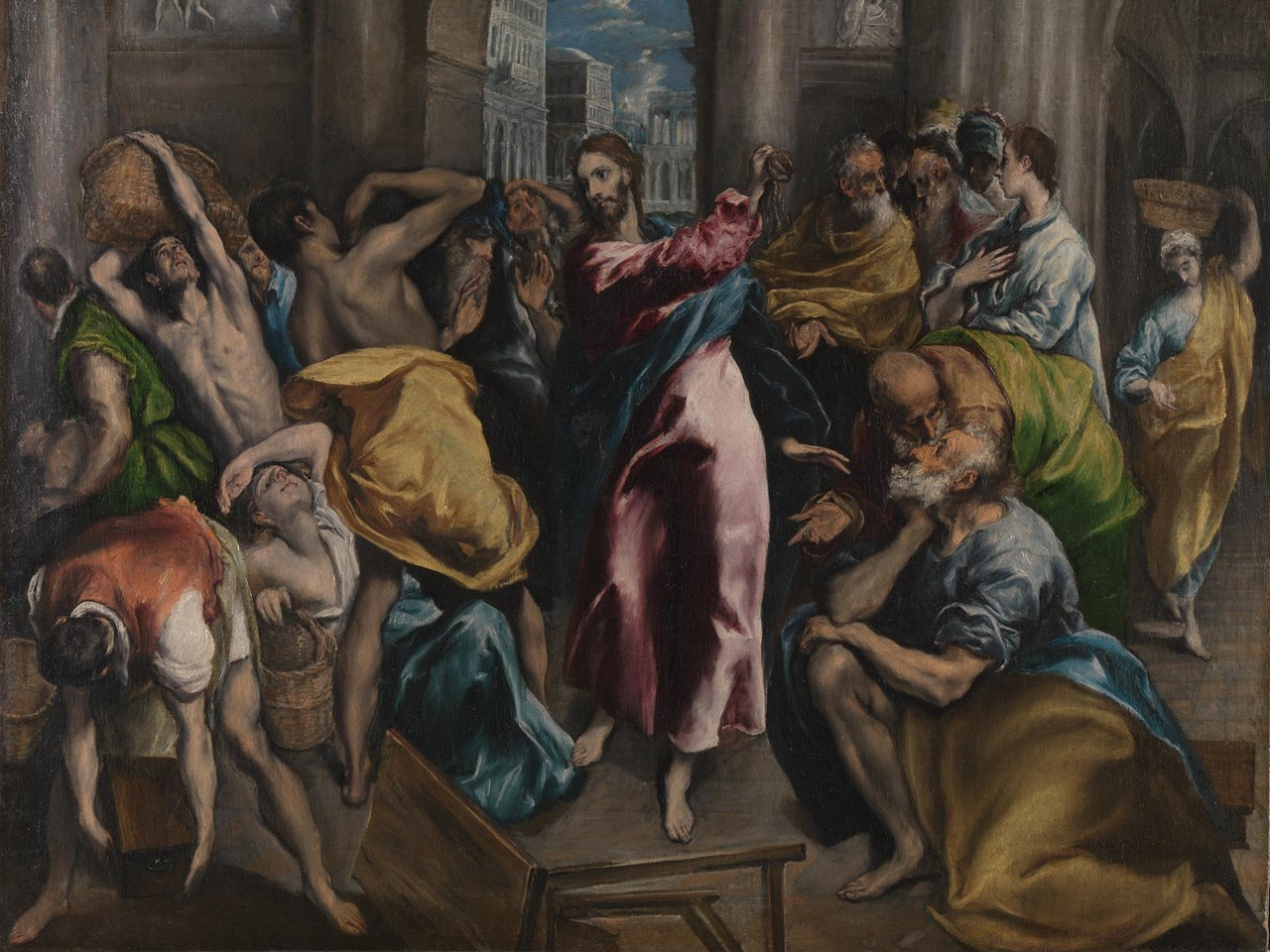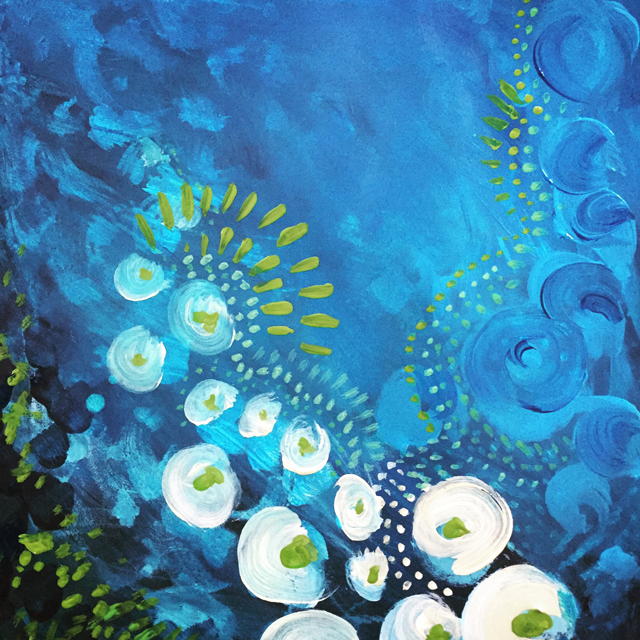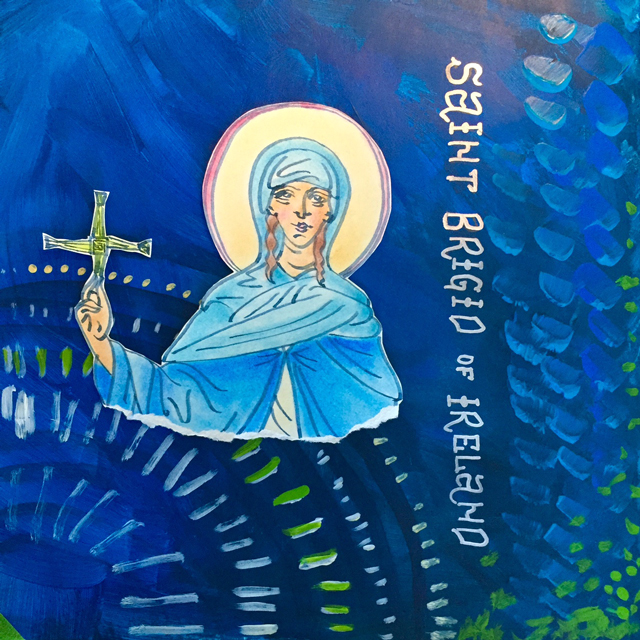Remembering Goodness
Working on Gabriel the Messenger created on an abstractly painting background
Jesus came to the temple. He drove out all those who were buying and selling. He upended the moneychangers’ tables and the dove-sellers’ benches.
Jesus: It is written, “My house will be a house of prayer for all people,” but you have turned this house of prayer into a den of robbers.
Then the blind and the lame came to the temple, and Jesus healed them. Rings of children circled round and sang, “Hosanna to the Son of David.” But the priests and scribes didn’t understand. When they saw the upturned tables, the walking paralytics, and the singing children, they were shocked, indignant, and angry, and they did not understand.
Priests and Scribes: Do you hear what these children are saying?
Jesus: Yes. Haven’t you read your own psalter? “From the mouths and souls of infants and toddlers, the most innocent, You have decreed praises for Yourself.”
At that, Jesus left Jerusalem. He went to Bethany, where He spent the night.
— Matthew 21:12-17 (The Voice Translation)
During my college days my artistic tastes began expanding. With the help, explanation and education of my college art professors, I came to understand and appreciate abstract art. I even began dabbling a bit in it myself. I never really made it much of a serious pursuit, but rather continued on the path of creating art that was far more often detailed and complex.

Abstract painting from the Fifth Sunday of Lent, 2020 by Michelle L Hofer
The pilgrimage I took in June of 2016 included the opportunity to visit two illuminated gospel displays. I found myself completely enamored with the tiny intricate designs crafted by Celtic Christians. I’ve determined that a project for the future will be to recreate the Chi Rho page from the Book of Kells in fabric. Where others would find such a project to be daunting and extremely overwhelming, I relish the challenge. And yet, over the past several years something within me has been calling me to explore the more playful and childlike methods and explorations of abstract art.
In 2017, I began a project that I am looking to continue – creating quick abstract painting backgrounds for portraits of Christian saints. I call it my Book of Saints Project and so far what little sharing I’ve done has been well received by my online followers. It has been quite freeing to simply choose a color pallet, put brush to paper and go. There are no rules here, no preconceived plan, no mistakes. It’s a pure “go with the flow” and “see where it leads” activity. This is play. So much planning, sketching, measuring, exact methodology, and execution is required for many of my projects, the abstract work feels primitive in comparison. What I am discovering though is that this is reconnecting me with my child-like ways of art making.
More and more I see play as a vital and necessary action for myself as an artist. One that keeps me balanced. One that informs my sense of adventure, risk-taking and courage.
When I am able to let go of fear and expectation and learn to be open in the process, I can explore new avenues of texture, coloration and composition. This in turn can help me to grow, expand, deepen and enrich my artistic understandings, experiences and outlook.
As I ponder this new endeavor, I can’t help but make think of the ways in which this is also on a spiritual level part of my own becoming like a child in order to enter the kingdom of heaven, to remember the goodness with which I was knit together in my mother’s womb.
To be an artist is to know symbolism, metaphor, it is to have the ability to look at anything and see its potential to represent something else. I find myself doing this often. And I find myself reading and understanding Scripture this way too. So for instance, we can look at the story of Jesus’ triumphal entry, which we explored in the last post as a symbol of His entry into our lives and hearts. His entry into Jerusalem was a celebration, and a time of questions…who is this? When Jesus entered your life, was it a joyous occasion? A time of questions: what does this mean?…who really is this Jesus?…what is He about?

Christ Driving the Traders from the Temple (probably before 1570) by El Greco (1541-1614)
In Matthew, Mark and Luke the story that follows immediately after the entry into Jerusalem is the clearing of the temple.
The account of this event as recorded in Matthew is fast becoming a favorite of mine when I look at it on a metaphorical or symbolic level thanks to a symbol for the body given by Paul to the Corinthians.
Do you not know that your body is a temple of the Holy Spirit, who is in you, whom you have received from God? — I Corinthians 6:19
As we grow up and transition from childhood to adulthood, life has a way of hardening us. We loose the trust, innocence, energy, joy and creativity we once had. We learn/experience the cruelties of the world, of each other. We suffer pain, hurt and betrayal. We develop fears and phobias. We take on habits and mindsets that further deform and harm us, inside and out. We can become bitter, cynical, judgmental, self-righteous, greedy, insensitive, and uncaring towards both ourselves and others. We can even loose our connection with God and a clear understanding of faith.
The money-changers thus become the symbol of the sin that takes root/sets up shop in our hearts. But if Jesus has entered into the city, he’s headed straight to the temple to drive what is corrupt out. So it must be the same within us. In the life of a believer, the transformation must begin until we can once again fully trust, love, embrace, and enjoy life like we once did as children…“for the kingdom of heaven belongs to such as these,” Jesus tells us (Matt 19:16).
Paul speaks often of the arduous ongoing work of “overturning the tables” within us in
Banish bitterness, rage and anger, shouting and slander, and any and all malicious thoughts—these are poison. Instead, be kind and compassionate. Graciously forgive one another just as God has forgiven you through the Anointed, our Liberating King.
So imitate God. Follow Him like adored children, and live in love as the Anointed One loved you—so much that He gave Himself as a fragrant sacrifice, pleasing God.
— Ephesians 4:31-5:2
If we go on we read as Jesus is over-turning tables he says, “It is written: My house will be called a house of prayer…” And so it must be also in us. We are to be a house of prayer…in the heart, central to who we are and what we do both individually and collectively.
When my grandmother was in the final stages of her life, her body has begun the process of shutting down. The last few visits I made she was weak and tired and mostly slept. When our family came together to celebrate her 94th birthday, she was wheeled around the party, introduced to various guests, had her photo taken with children, grandchildren and great-grandchildren but all while remaining fairly sleepy. What struck me that afternoon was where grandma’s mind was whenever someone tried to wake her. She was praying. If she heard a name, she repeated it in a prayer for the individual. Several times I heard phrases from the Lord’s Prayer. It fascinated me how her sleepy, semi-conscientious state was one of intercession and prayer.
Matthew next tells us there in the temple Jesus sets about he ministry work of healing and doing “wonderful things”. The exact work we welcome the Spirit to do in us and through us.
Is there something in you now that needs healing? encouragement? strength? hope? joy?
Finally, in the passage we come to perhaps the most lovely detail of all. Matthew shares that the children have come too and they are now shouting (and I would imagine jumping, twirling and whirling with full on exuberance, excitement and enthusiasm): “Hosanna to the Son of the David”!
It’s how the Spirit’s work in us reaches completion as well — we become like children from which praise and adoration of God erupt. A vision of goodness and wholeness.
In my personal journey to explore and discover the possibilities abstract painting can afford, I’ve had some help and encouragement along the way. Abstract Artist Flora Bowley is one such source of inspiration and I love how she sees it her mission to do just that for people:
I’ve been weaving my love of art, healing and community with a lifelong obsession to create with soulful, wild abandon. I recognize this desire to create freely as a basic, human need, and I’m honored to serve as a guide for others back to this place of mystery, magic and possibility. We are all born with infinite wells of creative potential just waiting to be tapped and remembered. I believe it’s time to remember. — Flora Bowley

The Generosity of Saint Brigid – Part 1, 2017 by Michelle L Hofer
The artwork I am sharing with you today is my abstract painting entitled, “The Generosity of Saint Brigid – Part 1” from my Book of Saints Project. With these abstract paintings, my focus is to express with simple color and shape something of the life and work of a given saint. So far I have completed 6 of these saint painting/portraits. This particular painting has been the favorite among my online followers. So to end I will leave you Brigid’s story:
All it took was hearing Patrick (the first evangelist to Ireland) preach to turn a young girl into a force for charity. Young Brigid was captivated by the invitation to new life being extended across the rolling hills of Ireland by a man named Patrick.
Upon her conversion she immediately began to minister to the poor and sick around her by dipping into the plentiful stores belonging to her father. Concerned that Brigid’s generosity could not be curbed and his own wealth would soon be gone, he set off with her in the hopes of marrying Brigid off to a local king. Brigid waited outside on her father’s carriage and when a poor leper approached her, she gave him the only thing left with her, the jewel encrusted sword of her father. In returning to the carriage and seeing the sword missing, Brigid’s father flew into a rage which of course the king observed and adamantly refused to accept the girl thinking he too would be taken for all he had.
At his wits end it would seem, Brigid’s father resigned that perhaps she was best suited for a religious life and was allowed to enter a convent. Here Brigid grew in wisdom and reputation and soon founded a double monastery of her own (meaning for both men and women) at Kildare in Ireland. She was a courageous woman said to possess miraculous healing powers and was a role-model to the many who aspired to the Christian faith. Her monastery became renowned both in Ireland and Europe, notably for its unprecedented hospitality (“a clean house, a big fire, and a couch without sorrow” became common attributes under Brigid’s influence).
Brigid traveled the countryside administering care and compassion on all she met. It is said that upon entering the home of a sick man, she fashioned a simple woven cross out of reed grass telling the gospel story as she wove which led to the man’s conversion . This cross-weaving tradition has been handed down through the ages in her honor.
Brigid also founded a school of art (for metal work and Scripture illumination) and was even appointed a bishop in the newly rising Celtic church. She oversaw other bishops, abbots and abbesses (male and female heads of monasteries), further proof that the Celts were approaching the faith through their own understandings of what was acceptable before God. The Irish were not unaccustomed to strong female leaders, so her role was not unusual in that regard.
So beloved is Brigid that some pretty amazing tales are told about her. And this is the table grace associated with Brigid (an ample picture of her youthful emblazoned heart of compassion):I should like a great lake of finest ale
For the King of kings.
I should like a table of the choicest food
For the family of heaven.
Let the ale be made from the fruits of faith,
And the food be forgiving love.I should welcome the poor to my feast,
For they are God’s children.
I should welcome the sick to my feast,
For they are God’s joy.
Let the poor sit with Jesus at the highest place,
And the sick dance with the angels.God bless the poor,
God bless the sick,
And bless our human race.
God bless our food,
God bless our drink,
All homes, O God, embrace.

The Generosity of Saint Brigid – Part 2, 2017 by Michelle L Hofer
When we can work with the Spirit’s guidance and assistance at becoming child-like again, we remember the goodness at the heart of who we are created to be. Christ has come that you may be set free and “have life, and have it to the full.”
How can you invite the children to jump and sing and praise within you?
What does this becoming child-like look like or involve for you personally?
Where in your life is there an invitation to remember goodness?
Down an Ancient Path
The BIRCH TREE STUDIO BLOG
